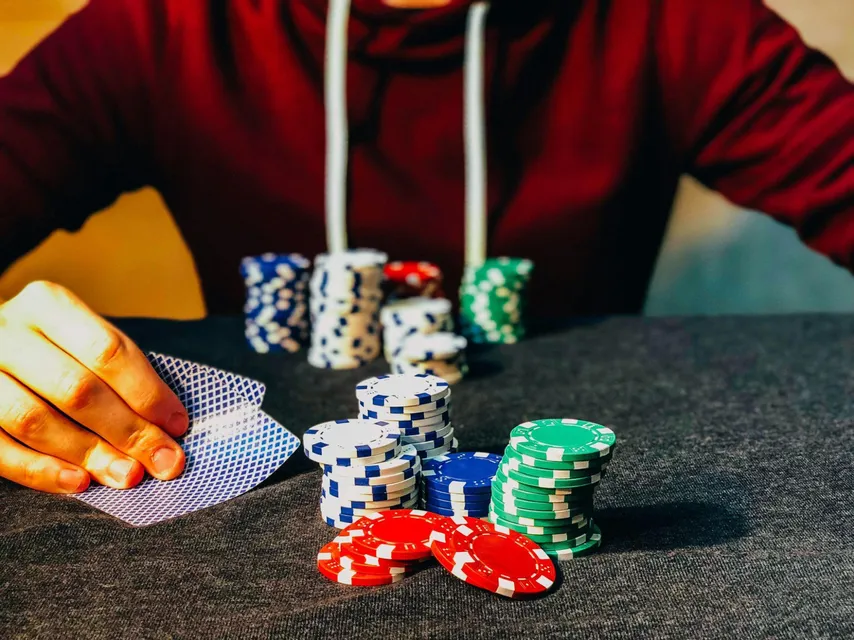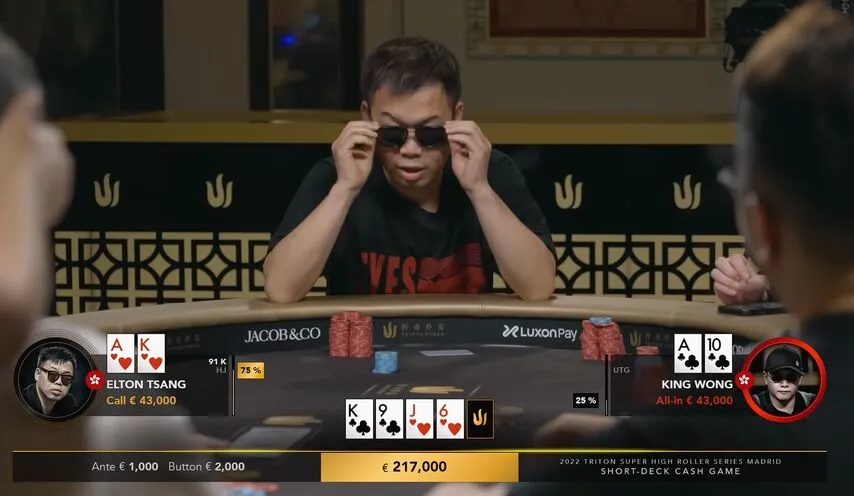Many novice poker players believe that the game is one complete bluff. Pick up some cards, bet big, raise any opponent, and take down a pot while smiling from ear to ear. Hollywood’s various films about poker, where players win millions by sheer courage, created this mirage.
However, in real life, everything is somewhat different. Bluffing is important, but you need to learn how to use it in the right situations. Beginners should be especially careful with this technique, since at micro-limits, opponents are often not ready to fold their cards, no matter what you portray.
So, what is bluff equity? Also, how can you calculate it and apply it in games? We’ll explain that now, plus recommend your next avenues of improvement.

What Is Bluff Equity?
In poker, there are two ways to win a hand:
- Get the best hand combination.
- Convince your opponents that you have it by bluffing.
If you have the best combination, you win the hand at showdown.
Bluffing is more complicated, as you need to know the strength of combinations and guess the probability that your opponent will fold in response to your bet. This is called bluff equity. The indicator calculates how often your bluff must succeed for the bet to be profitable.
In modern poker, we often use the term “fold equity” instead of “bluff equity.”
Fold equity lets us know how likely and profitable it is to pressure our opponent to fold, just as bluff equity does.
How to Calculate Bluff Equity
To learn how to calculate bluff equity, use this formula:
EV (FE) = [EV(fold)] * x + [EV(call)] * (1-x)
During a hand, there isn't enough time to use the formula. A simpler method is to calculate the break-even point, which shows the percentage of bluffs that must pass for a bet to be successful.
Example: If you bet 25% of the pot, your opponent must fold at least 20% of their hands for it to be profitable. They may fold more often, meaning that you'll profit.
Here's a table of bluff break-even points for different bet sizes:
| Rate (% of the pot) | Break-even % |
|---|---|
| 25% | 20% |
| 30% | 23% |
| 44% | 31% |
| 50% | 33% |
| 70% | 41% |
| 85% | 46% |
| 100% | 50% |
| 120% | 54% |
| 150% | 60% |
The break-even point is the minimum bluff equity at which bluffing makes sense.
Factors That Affect Bluff Equity (and Fold Equity)
Bluff equity depends on several factors:
- Bet size: Opponents will fold more often to larger bets if they miss the board.
- Pot size: It's psychologically easier to fold when the pot is small.
- Opponent type: Some players, ironically called "calling stations," rarely fold. Bluffing them isn't advisable.
- Your table image: If you play many hands, your bets will be less credible, making bluffing harder.
- Board structure: Some board textures favor the aggressor (high card boards), while others favor the caller.
Tweaking some of these factors and perfecting bluffs can take time, which is why we’d recommend that you play on low stakes during the testing period.
- GipsyTeam's unique promotions
- Help with deposits and cashouts
- Access to private freerolls
- Round-the-clock support
- GipsyTeam's unique promotions
- Help with deposits and cashouts
- Access to private freerolls
- Round-the-clock support
- GipsyTeam's unique promotions
- Help with deposits and cashouts
- Access to private freerolls
- Round-the-clock support
- Уникальные акции от GipsyTeam
- Помощь с депозитами и кешаутами
- Доступ в закрытые фрироллы
- Круглосуточная поддержка
- Уникальные акции от GipsyTeam
- Помощь с депозитами и кешаутами
- Доступ в закрытые фрироллы
- Круглосуточная поддержка
- GipsyTeam's unique promotions
- Help with deposits and cashouts
- Access to private freerolls
- Round-the-clock support
- Уникальные акции от GipsyTeam
- Помощь с депозитами и кешаутами
- Доступ в закрытые фрироллы
- Круглосуточная поддержка
- GipsyTeam's unique promotions
- Help with deposits and cashouts
- Access to private freerolls
- Round-the-clock support
- GipsyTeam's unique promotions
- Help with deposits and cashouts
- Access to private freerolls
- Round-the-clock support
- GipsyTeam's unique promotions
- Help with deposits and cashouts
- Access to private freerolls
- Round-the-clock support
- GipsyTeam's unique promotions
- Help with deposits and cashouts
- Access to private freerolls
- Round-the-clock support
- GipsyTeam's unique promotions
- Help with deposits and cashouts
- Access to private freerolls
- Round-the-clock support
- GipsyTeam's unique promotions
- Help with deposits and cashouts
- Access to private freerolls
- Round-the-clock support
- GipsyTeam's unique promotions
- Help with deposits and cashouts
- Access to private freerolls
- Round-the-clock support
- GipsyTeam's unique promotions
- Help with deposits and cashouts
- Access to private freerolls
- Round-the-clock support
- GipsyTeam's unique promotions
- Help with deposits and cashouts
- Access to private freerolls
- Round-the-clock support
- GipsyTeam's unique promotions
- Help with deposits and cashouts
- Access to private freerolls
- Round-the-clock support
- GipsyTeam's unique promotions
- Help with deposits and cashouts
- Access to private freerolls
- Round-the-clock support
- GipsyTeam's unique promotions
- Help with deposits and cashouts
- Access to private freerolls
- Round-the-clock support
- GipsyTeam's unique promotions
- Help with deposits and cashouts
- Access to private freerolls
- Round-the-clock support
- GipsyTeam's unique promotions
- Help with deposits and cashouts
- Access to private freerolls
- Round-the-clock support
- GipsyTeam's unique promotions
- Help with deposits and cashouts
- Access to private freerolls
- Round-the-clock support
- Уникальные акции от GipsyTeam
- Помощь с депозитами и кешаутами
- Доступ в закрытые фрироллы
- Круглосуточная поддержка
- GipsyTeam's unique promotions
- Help with deposits and cashouts
- Access to private freerolls
- Round-the-clock support
- GipsyTeam's unique promotions
- Help with deposits and cashouts
- Access to private freerolls
- Round-the-clock support
- GipsyTeam's unique promotions
- Help with deposits and cashouts
- Access to private freerolls
- Round-the-clock support
- GipsyTeam's unique promotions
- Help with deposits and cashouts
- Access to private freerolls
- Round-the-clock support
- GipsyTeam's unique promotions
- Help with deposits and cashouts
- Access to private freerolls
- Round-the-clock support
- GipsyTeam's unique promotions
- Help with deposits and cashouts
- Access to private freerolls
- Round-the-clock support
- Уникальные акции от GipsyTeam
- Помощь с депозитами и кешаутами
- Доступ в закрытые фрироллы
- Круглосуточная поддержка
- GipsyTeam's unique promotions
- Help with deposits and cashouts
- Access to private freerolls
- Round-the-clock support
- GipsyTeam's unique promotions
- Help with deposits and cashouts
- Access to private freerolls
- Round-the-clock support
- Уникальные акции от GipsyTeam
- Помощь с депозитами и кешаутами
- Доступ в закрытые фрироллы
- Круглосуточная поддержка
- GipsyTeam's unique promotions
- Help with deposits and cashouts
- Access to private freerolls
- Round-the-clock support
- Уникальные акции от GipsyTeam
- Помощь с депозитами и кешаутами
- Доступ в закрытые фрироллы
- Круглосуточная поддержка
- Уникальные акции от GipsyTeam
- Помощь с депозитами и кешаутами
- Доступ в закрытые фрироллы
- Круглосуточная поддержка
- GipsyTeam's unique promotions
- Help with deposits and cashouts
- Access to private freerolls
- Round-the-clock support
- GipsyTeam's unique promotions
- Help with deposits and cashouts
- Access to private freerolls
- Round-the-clock support
- GipsyTeam's unique promotions
- Help with deposits and cashouts
- Access to private freerolls
- Round-the-clock support
- Уникальные акции от GipsyTeam
- Помощь с депозитами и кешаутами
- Доступ в закрытые фрироллы
- Круглосуточная поддержка
- GipsyTeam's unique promotions
- Help with deposits and cashouts
- Access to private freerolls
- Round-the-clock support
- GipsyTeam's unique promotions
- Help with deposits and cashouts
- Access to private freerolls
- Round-the-clock support
- GipsyTeam's unique promotions
- Help with deposits and cashouts
- Access to private freerolls
- Round-the-clock support
- GipsyTeam's unique promotions
- Help with deposits and cashouts
- Access to private freerolls
- Round-the-clock support
- Уникальные акции от GipsyTeam
- Помощь с депозитами и кешаутами
- Доступ в закрытые фрироллы
- Круглосуточная поддержка
- GipsyTeam's unique promotions
- Help with deposits and cashouts
- Access to private freerolls
- Round-the-clock support
- GipsyTeam's unique promotions
- Help with deposits and cashouts
- Access to private freerolls
- Round-the-clock support
Poker Hand Categories for Bluffing
There are two main categories:
1. Pure bluff: Your cards have no connection to the board and little chance of improving. Bluffing is the only way to win since creating a better combination is very unlikely.
2. Semi-bluff: Betting with a hand that could improve to win, like a draw to a flush or straight. It provides a backup plan if your bluff is called.

Methods to Learn Poker Effectively
Every player can learn to bluff, but mastering other poker techniques is crucial for consistent profits. Expect to spend significant time studying. Here are some effective ways to improve your game:
1. Personalized training: Lessons with an experienced coach provide tremendous experience and knowledge. Training at micro-limits is affordable for beginners. If you play at the lowest limits, consider applying to a poker school for additional funds.
2. Hand analysis: Regularly analyze your hands using specialized poker software. The GipsyTeam Shop offers popular programs like Holdem Manager 3 and Hand2Note at the best prices.
3. Free content: There's plenty of free educational content online. This content includes useful articles or videos that improve your game. Cruise through our catalog to find the information you need, and watch Twitch or YouTube.
4. Playing for money: Regular practice at the tables is essential. You can even win your first money for free! Our website has a list of freerolls (tournaments with no entry fee). GipsyTeam also organizes more profitable closed tournaments. If you can’t see those on our schedule, just send us a quick message online.
If you need help registering at poker rooms or have any online poker questions, contact the free GipsyTeam support service. Specialists are available 7 days a week via Telegram, Skype, and Discord. They'll help you get bonuses, recommend the best promotions and freerolls, and assist with software installation. Contact us!
- Increased rakeback and personal bonuses
- Help with deposits and cashouts
- Access to mobile applications
- Solving problems with accounts
- Technical support
- Questions about the site and forum

















